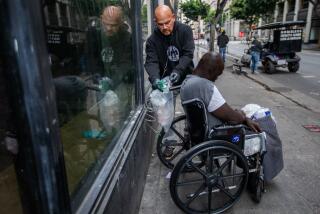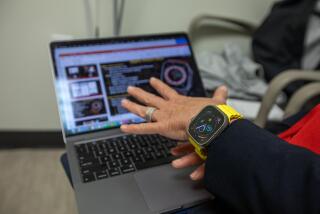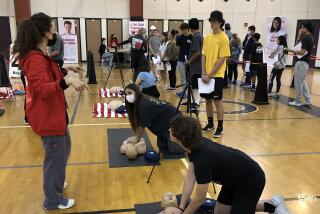A High-Tech ‘Miracle’ Saves Baby Miguel
- Share via
Nurses at Childrens Hospital of Orange County have posted a sign on 1-month-old Miguel Pacheco’s crib. “Miracle Miguel” it reads.
But for a special medical team and a heart-lung bypass machine that shunted the blood from Miguel’s body, pumped it through a silicone membrane and filled it with the oxygen Miguel’s failing lungs could not provide--the baby would have died, pediatric surgeon Barbara Towne said.
Close to Death
In fact, a week after he was born Miguel came close to death. “About two minutes before we put the baby on the machine, he had no blood pressure and no heart rate. He was very blue; he was clinically dead,” hospital nurse coordinator Terri Zeilinger recalled. “We hooked him up to the machine, and he came alive again. He was instantaneously pink.”
Wearing pajamas decorated with rabbits, the dark-haired, 6 1/2-pound boy snuggled in the arms of his mother, 24-year-old Hue Pacheco of Anaheim, at the hospital’s neonatal intensive care unit last week. Miguel, who has been off the bypass machine for about two weeks, is still hooked to plastic tubing that brings him food and oxygen. But once he begins taking food from a bottle, probably in a week, doctors say he can go home. And they say his prospects for a normal life are good.
Miguel was the beneficiary of new medical technology for high-risk babies with respiratory failure called ECMO, for extracorporeal membrane oxygenation system (meaning a system that works outside the baby’s body).
ECMO is a last resort for babies who otherwise would have “a 90% to 100% chance of dying of respiratory failure,” said Towne, the director of the Childrens Hospital ECMO team. But with the machine, she said, babies like Miguel have a 75% chance of living and leading normal lives.
The $20,000-machine--a complex system of tubing, catheters, a pump and the silicone membrane “lung,” all contained on a shiny chrome cart--was invented in the early 1970s by two UC Irvine doctors, Peter Bartlett and Alan Gazzaniga, who conducted some of their first trials at Childrens Hospital. But in 1982, when the technology was still considered experimental, Bartlett moved to the University of Michigan in Ann Arbor, taking the technology with him.
It is no longer considered experimental, but it is still unusual. The heart-lung bypass machine is available at approximately 30 hospitals throughout the nation, five in Southern California.
“The return of ECMO to Orange County really is a major step,” said Dr. Devin Cornish, the San Diego regional ECMO coordinator. “Its efficacy at saving high-risk babies is well demonstrated. And the number of patients who could be saved in no other way is large enough that the absence of this as a resource is a large negative.”
Flew Machine to Santa Ana
Cornish has had personal experience with the negatives. Last January, Cornish, then an Air Force doctor who headed an ECMO team from San Antonio, Tex., flew the heart-lung machine to Western Medical Center in Santa Ana to try to save a 2-day-old girl with respiratory failure. Other West Coast hospitals with the technology were unable to take the baby.
But Cornish and his team arrived too late. “I walked in. A doctor took me aside and said the baby had just died,” Cornish said. “I can’t say the baby could have been saved, but there are on the order of 40 to 80 babies in your area (each year) who are likely to be saved with this technique and no other technique.”
There are risks to the system, Towne noted: a blood-thinning drug used with it can cause bleeding in the brain. And there are limits to its use. Babies must be no more than two weeks premature and weigh more than 4 1/2 pounds.
Also the complex technology requires extensive training. Towne said she initially learned how to use the machine in the 1970s, working with Bartlett and Gazzaniga, but that her full team, which includes 14 nurses, three surgeons and five neonatologists, took a year to train. The treatment is also expensive--an additional $2,000-a-day beyond the usual $2,000-a-day cost for intensive care, Childrens Hospital spokeswoman Maureen Williams said. Two technicians must sit by the baby’s bed to monitor the equipment 24 hours a day.
Miguel was born one week premature on July 13. Hospital officials said he was sick from birth. He suffered persistent pulmonary hypertension, a potentially fatal condition in which the blood vessels in the lung were unable to oxygenate his blood.
Just before Miguel was placed on the ECMO equipment, he had to be resuscitated from a cardiac arrest, Towne said. “He was profoundly ill,” she said; the machine was his last hope.
It took two hours to prime the machinery, put a large catheter into two blood vessels in the right side of Miguel’s tiny neck and then pump his blood through the silicone membrane that infused the blood with oxygen, Towne said. But the treatment worked. “His heartbeat returned to normal, and his blood pressure stabilized within moments.”
Miguel remained hooked to the equipment for a week. As his damaged lungs recovered, he was weaned off the machine. Though the new machine did what it was supposed to do, doctors and nurses nevertheless called Miguel’s recovery amazing. “He was in effect dead or dying when we put him on ECMO. The fact that he recovered is certainly a miracle,” Towne said.
Still recuperating, Miguel wriggles in his crib and smiles at his mother who visits him every day. “He still has the IV and the oxygen, but he makes so much progress, “ Hue Pacheco said.
Meanwhile, the chrome cart that carries the ECMO equipment is locked in a closet down the hall from Miguel’s crib--ready for the next baby.
More to Read
Sign up for Essential California
The most important California stories and recommendations in your inbox every morning.
You may occasionally receive promotional content from the Los Angeles Times.










